- Stat Significant
- Posts
- How Have Song Lyrics Changed Since the 1960s? A Statistical Analysis
How Have Song Lyrics Changed Since the 1960s? A Statistical Analysis
How have song lyrics evolved over time?
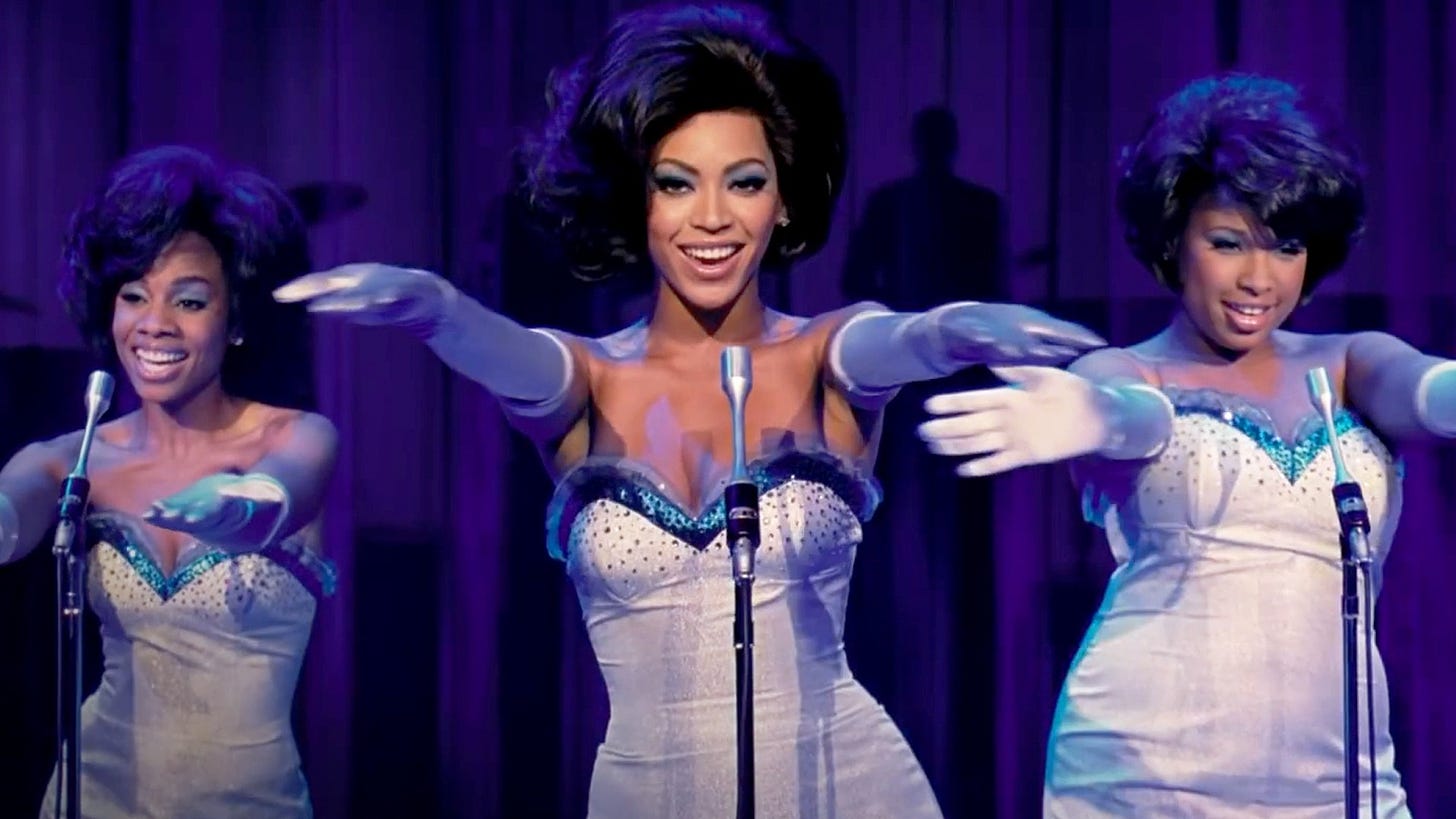
Dreamgirls (2006). Credit: DreamWorks Pictures and Paramount.
Intro: 3,400 Years of Lyrics
In the early 1950s, a group of French archaeologists stumbled upon a collection of 36 clay tablets during an excavation project in Northern Syria. Dating back to 1400 BCE, these engravings, now known as the Hurrian Hymns, are thought to be the oldest known example of written music.
However, one tablet in particular stood out to researchers. Featuring musical notations, accompanying lyrics, and tuning instructions, "Hurrian Hymn No. 6," a psalm praising an ancient fertility goddess named Nikkal, was the lone inscription that remained fully intact and represents humanity's first known attempt to document lyrics alongside music.
Flash forward a brief 3,400 years to 1997, and the release of Daft Punk's electro house hit "Around the World," a song notable for what could be considered "extreme minimalism." Peaking at number 64 on the Billboard Charts, the lyrics for Daft Punk's breakout hit consist of the phrase "around the world" repeated 144 times throughout the track's seven-minute run time.
Could you imagine what this song might look like if documented via stone tablet, with some poor soul chiseling seven minutes worth of "around the world" into clay? Some consider this song subversive for its unapologetic repetition (as if the tune is post-lyrics), while others find its lack of linguistic diversity annoying.
Still, both "Hurrian Hymn No. 6" and "Around the World" have been documented for posterity's sake, one for religious worship and the other so that people may Google it. Yet, their lyrical stylings span three thousand years of ever-changing linguistic complexity, emotional depth, and melodic redundancy.
So today, we'll explore how lyrics have changed in the age of recorded music, examining transformations in sentiment, sophistication, and repetition. We'll explore the ascendent genres that spurred these changes and the ceaseless evolution of music and lyrics over the last seventy years.
Are Song Lyrics Becoming More Negative?
In 1992, Ice-T released the song "Cop Killer," a heavy metal rap anthem protesting police brutality. The song was a direct response to the beating of Rodney King and the 1992 Los Angeles riots. Ice-T's polemical screed describes a fictional scenario where someone takes violent revenge on several corrupt police officers. Although "Cop Killer" was intended as a social commentary on systemic racism and police misconduct, the track faced intense backlash for its perceived promotion of violence against law enforcement. Amid mounting pressure, Ice-T voluntarily removed the song from future album pressings.
"Cop Killer" is a notable entry in a canon of late-20th century hip-hop protest songs alongside works like "F**k the Police," "The Message," and "Fight the Power." These tracks achieved mainstream listenership and subsequently courted the attention of censors and "concerned parents."
However, the intention behind these works went beyond profanity for profanity's sake. Artists like Public Enemy and The Furious Five used rap to depict the frustrations and social realities of marginalized communities, documenting issues surrounding police brutality, poverty, and street life. The backlash against this music came from critics who took these lyrics at face value, condemning their explicit content and assuming they endorsed immorality.
Starting in the late 1980s, rap and hip-hop rose from humble beginnings in the South Bronx to become a global cultural phenomenon. By the turn of the century, rap and pop had overtaken rock as the music industry's best-selling genres.
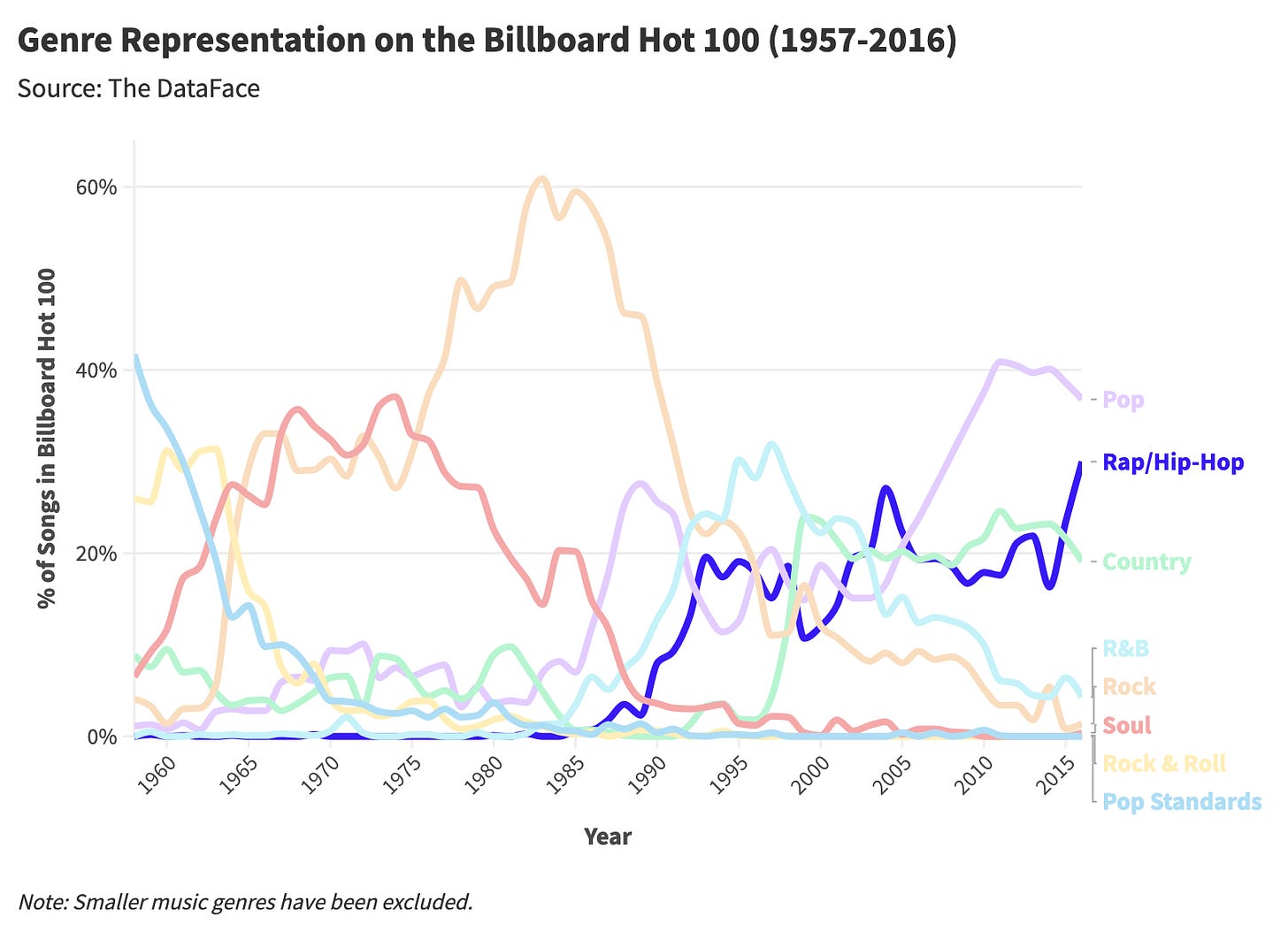
Commensurate with hip-hop's rise, we observe a drastic decline in lyrical positivity, as determined by algorithmic sentiment analysis.
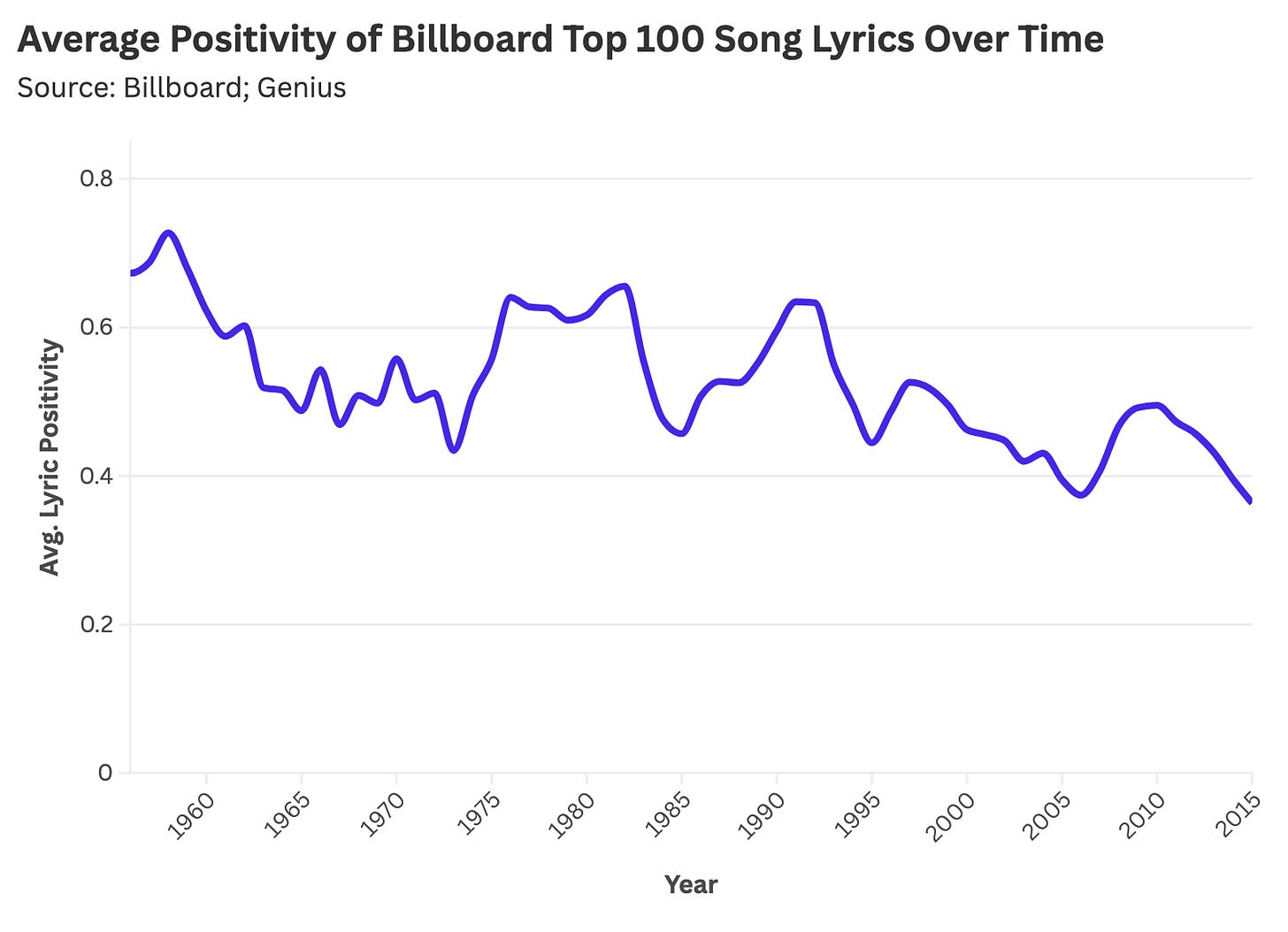
When we examine the genres and keywords most strongly associated with negative lyrics, our list is mostly comprised of rap subgenres such as Gangster Rap, Dirty South, and West Coast Hip-hop.
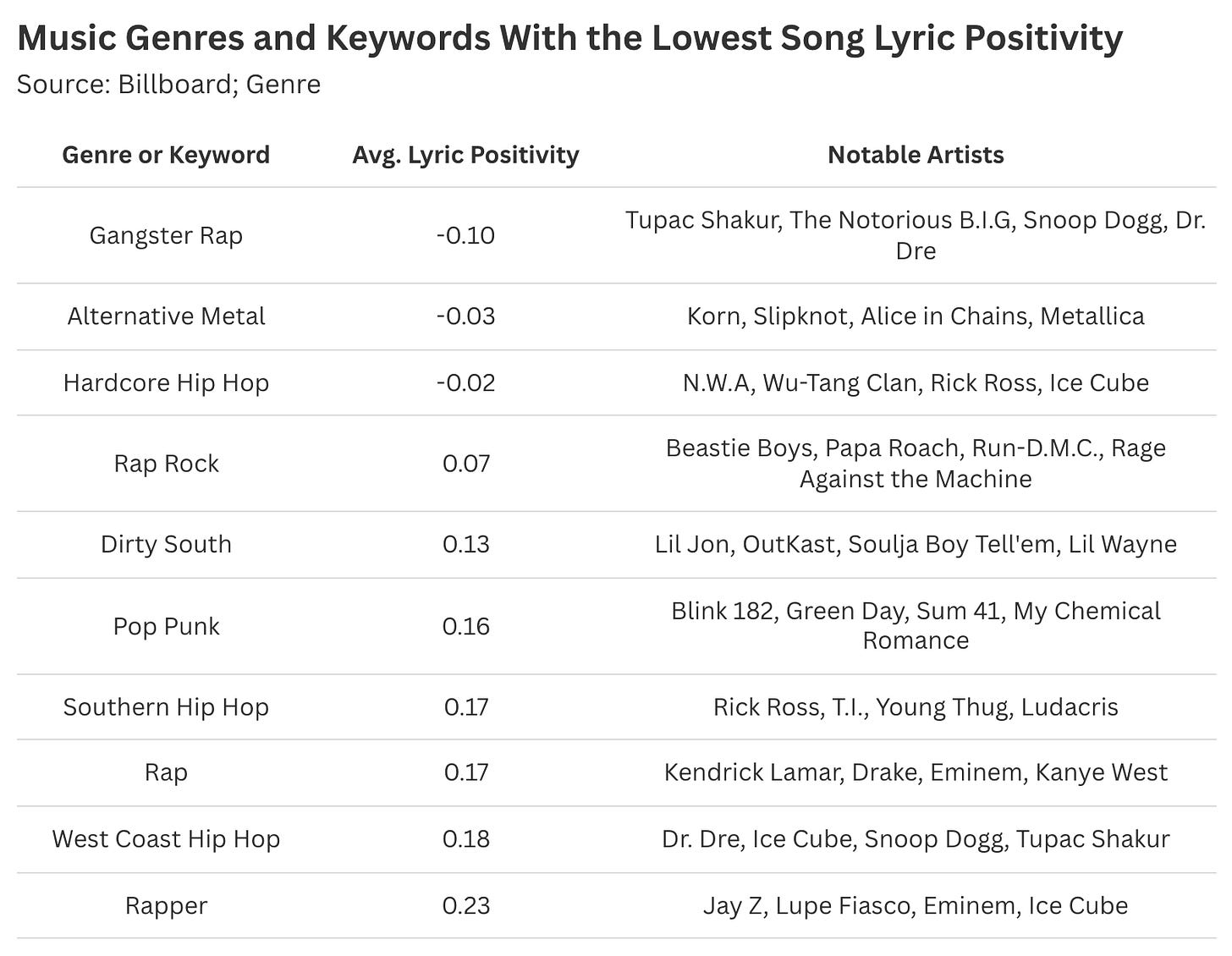
If you're Tipper Gore (wife of Al Gore) or the Parents Music Resource Center, you may see this data point as an affirmation of your belief that rap is some kind of moral hazard—like violent video games or Tide Pods. And yet, there's a depth to these songs that eludes both censors and algorithms.
Consider Ice Cube's "Today Was a Good Day." If you're a "concerned parent" or natural language model, you may consider this song "explicit" or "negative" and call it a day. Yet embedded within this track lies the pervasive pressures of life in a marginalized community—juxtaposing declarations of defiance with expressions of overwhelming anxiety. Here is a sample of some of the song's most iconic lines:
"Hooked it up for later as I hit the door Thinkin', 'Will I live another 24?'"
"Today I didn't even have to use my A.K., I gotta say it was a good day"
"Plus, nobody I know got killed in South Central L.A. Today was a good day"
Contrary to what Tipper Gore and the Parents Music Resource Center suggest, lyrical negativity should not be mistaken for diminished cultural value.
Are Lyrics Becoming More Complex?
Hip-hop and rap emerged in the mid-1970s, evolving from a mix of African American musical traditions, including funk, spoken word, and jazz, combined with New York City street culture. In the South Bronx, an early hip-hop pioneer named D.J. Kool Herc introduced the use of two turntables to loop breakbeats while he "toasted" or spoke rhythmically over these beats.
Over time, this "toasting" would come to define rap and hip-hop, two genres widely considered "lyric-driven." Unsurprisingly, this lyric-driven artform boasts greater linguistic complexity than other genres—as determined by an algorithm. Beginning in the late 1980s, the average lyrical complexity of Billboard-charting music increased alongside rap's growing cultural influence.
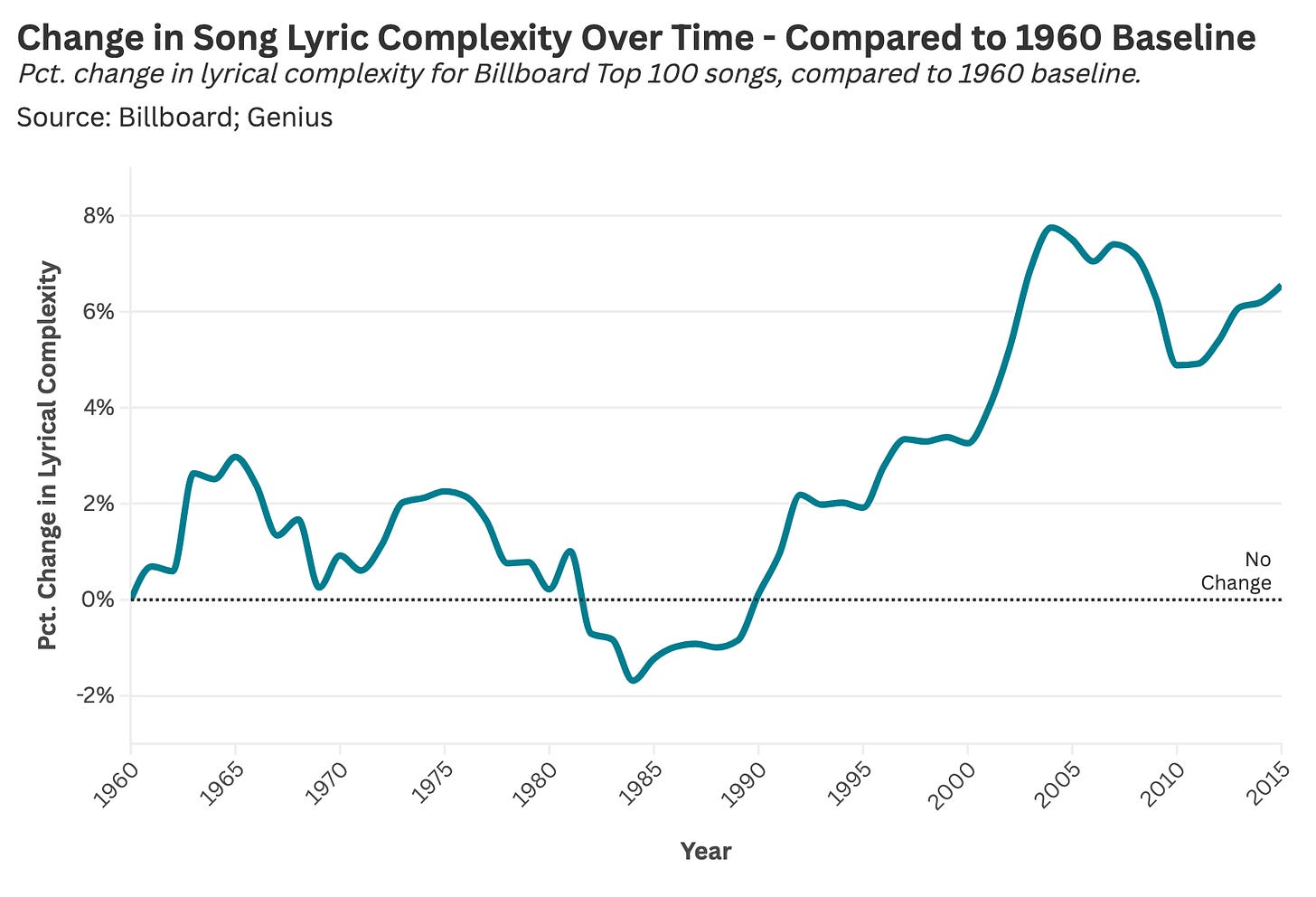
When we analyze the genres and keywords that rank highly on our lyrical complexity metric, we find a variety of hip-hop subgenres.
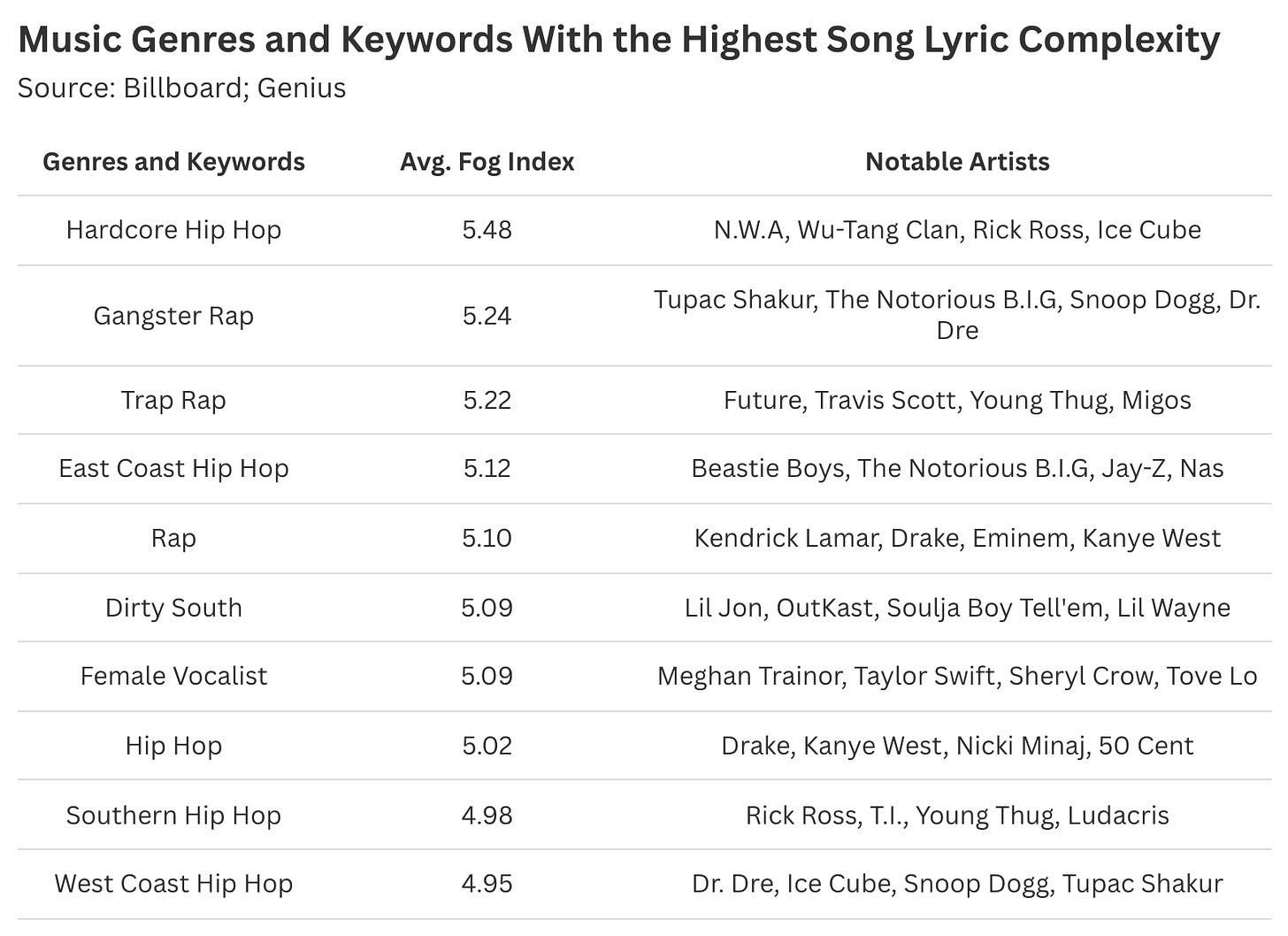
These figures highlight the artform's emphasis on lyrical mastery and linguistic dexterity. Rap has brought us Sir-Mix-a-Lot's "Baby Got Back" and Kendrick Lamar's DAMN. The former has served as a focal point of Bar Mitzvahs everywhere, while the latter won a Pulitzer Prize, cementing Lamar as a generational songwriting talent alongside Bob Dylan, Hank Williams, and Aretha Franklin.
Are Lyrics Becoming More Repetitive?
Do you remember the song "Tubthumping"? No? What about the band Chumbawamba? Also, no? What about these profoundly inspirational lyrics: "I get knocked down, but I get up again, you are never gonna keep me down." Surely, this must ring some bells.
Released in 1997, Chumbawamba's "Tubthumping" stands as one of the most unlikely chart-topping hits in music history. Why, you ask? Well, for starters, Chumbawamba was a U.K.-based anarcho-punk band formed to protest authoritarianism and the excesses of capitalism. Second, Chumbawamba's "Tubthumping" is exceptionally repetitive, composed of three distinct components (and that's about it):
The Iconic Chorus: "I get knocked down, but I get up again, you are never gonna keep me down."
Referential Pastiche: The Irish folk song "Danny Boy" is sung amidst the oft-repeated chorus.
References to Drinking: Interspersed between choruses, Chumbawamba speaks of "pissing the night away" and drinking "whiskey drinks" and "cider drinks."
90% of this song features some combination of these elements, yet this tune is a beloved, universally recognizable classic.
While often considered a mark of lesser songwriting talent, repetition isn't always a bad thing.
When we examine repeat words as a percentage of all song lyrics, we find two distinct periods of increased repetition: one coinciding with the 1980s and another beginning in the mid-2000s and continuing to the present day.
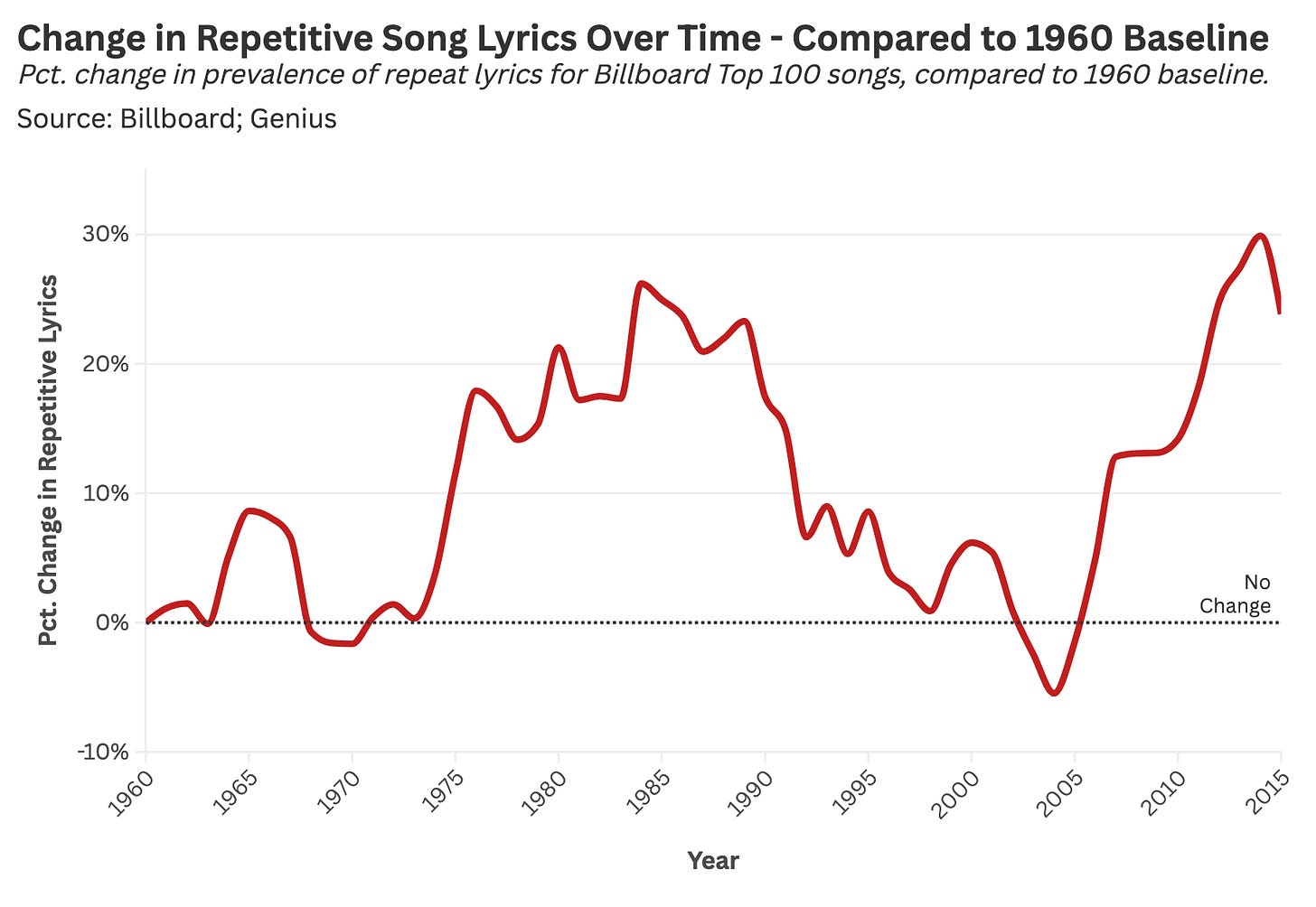
Here's a fun change of pace: rap is not the driving force behind these periods of increased repetition. The subgenres and keywords associated with above-average lyrical redundancy include Euro Pop, Synth Pop, and New Wave—explaining the spike in the 1980s—along with Electronic, House, and Dance, which are driving the recent rise in lyrical repetition.
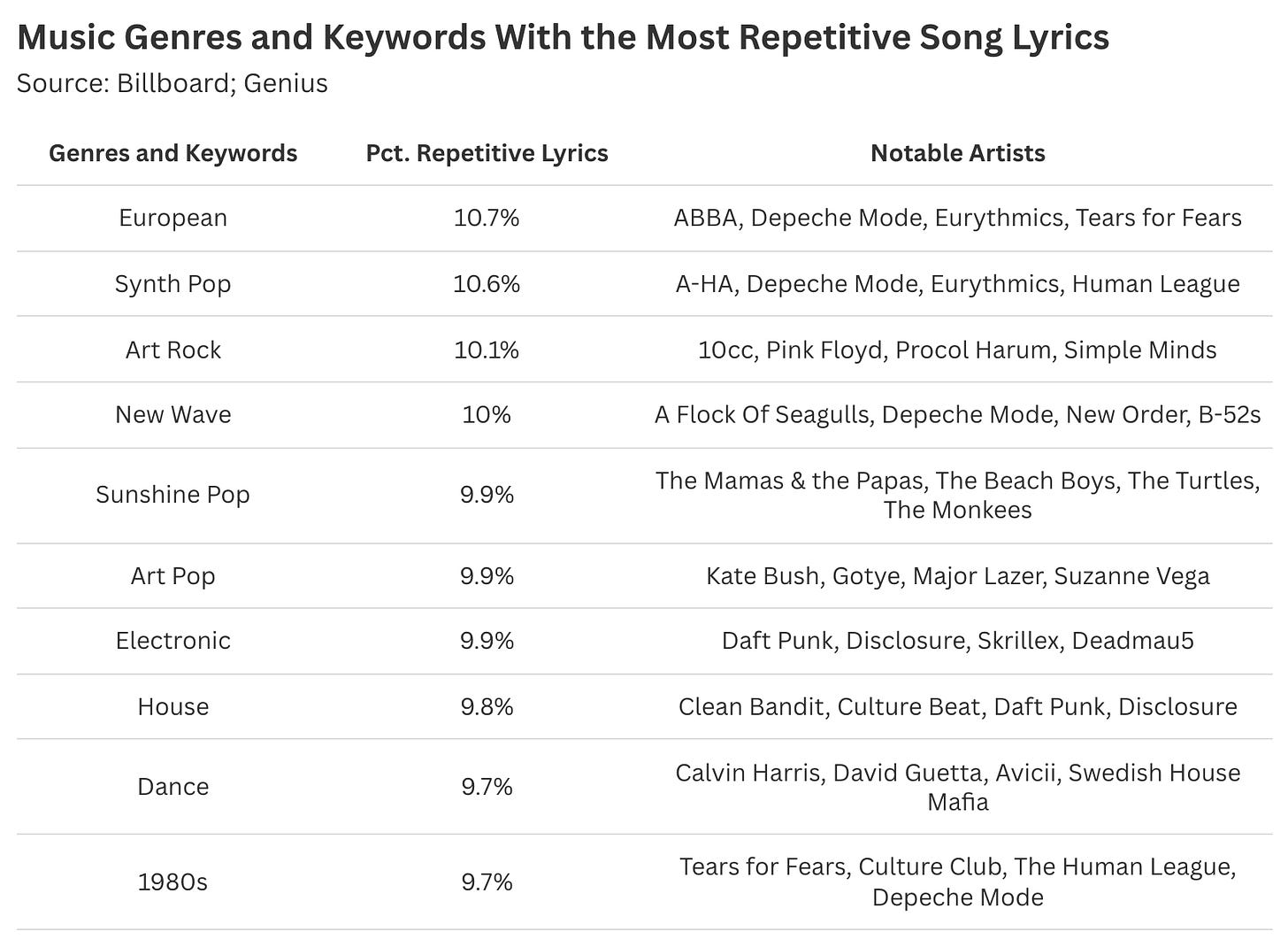
In the past 15 years, repetition has become a key element of modern songwriting as artists strive for social media virality and instant memorability. Pop stars achieve this immediate familiarity through short, catchy hooks that are relentlessly repeated to the point of sonic torture (and/or satisfaction).
Consider Sabrina Carpenter's "Espresso," a song I either hate or love, or both. With its oft-repeated chorus, this tune was expertly crafted for TikTok and/or someone with the memory of a goldfish. You can learn this song without ever intentionally listening to it, absorbing its lyrics through osmosis and brute force redundancy.
Final Thoughts: The Rise of Clarity
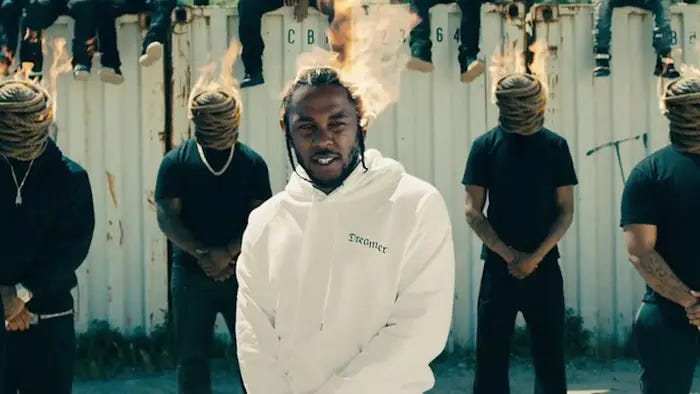
Music video for “Humble” by Kendrick Lamar.
A mondegreen refers to the mishearing of song lyrics, where this misinterpretation subsequently alters the work's meaning. The term was coined in 1954 by writer Sylvia Wright, who misheard a line from the Scottish ballad "The Bonnie Earl O' Moray," interpreting "laid him on the green" as "Lady Mondegreen." The mondegreen phenomenon has plagued numerous hit songs of the 20th century, including:
"Purple Haze" by Jimmy Hendrix: "Scuse me while I kiss the sky" is often overheard as "Scuse me while I kiss this guy."
"Tiny Dancer" by Elton John: Early listeners misheard "Tiny Dancer" to be actor "Tony Danza."
"I Want to Hold Your Hand" by The Beatles: Some thought the line "I can't hide" was "I get high."
The other day, while listening to Nirvana's "Smells Like Teen Spirit," I decided it was time to finally figure out what Kurt Cobain is actually singing. I Googled it and was shocked to learn that I was about 25% accurate in comprehending these lyrics. I don't think my poor recall of "Smells Like Teen Spirit" is uncommon, as the vagueness of these lyrics is core to the track's appeal, but this does beg a fascinating series of questions:
How could I misunderstand most of the lyrics to one of my favorite songs?
How could a song with universally misunderstood lyrics spend 20 weeks on the Billboard Charts?
What did Kurt Cobain mean when he sang, "A mulatto, an albino, a mosquito, my libido." Are these lyrics abstract on purpose? Is this song mostly coasting on vibes?
Yet the mondegreen phenomenon may be a thing of the past—an act of goofy happenstance that once afflicted music of a bygone era.
For starters, we now have the internet, which almost instantly resolves lyrical misinterpretation. Beyond the internet, the mondegreen's demise also stems from changing cultural appetites.
Today's mainstream music landscape is dominated by hip-hop and pop, two genres that rely on lyrical recognition and recall (at least, in their present form). Rap and hip-hop are lyric-driven; an artist's words are central to the song's appeal. Modern pop songs, on the other hand, are crafted for virality. Lyrics must be recognizable so the masses can lipsync these words in a TikTok video or instantly store them in long-term memory (in place of their social security number or email password).
Perhaps we've come full circle: lyrics are as significant now as they were in 1400 BCE. However, instead of praising ancient fertility goddesses, we're lipsyncing about being like an "espresso."
Thanks for reading Stat Significant! Subscribe for free to receive new posts and support my work.
Struggling With a Data Problem? Stat Significant Can Help!

Having trouble extracting insights from your data? Need assistance on a data or research project? Well, you’re in luck because Stat Significant offers data consulting services and can help with:
Insights: Unlock actionable insights from your data with customized analyses that drive strategic growth and help you make informed decisions.
Dashboard-Building: Transform your data into clear, compelling dashboards that deliver real-time insights.
Data Architecture: Make your existing data usable through extraction, cleaning, transformation, and the creation of data pipelines.
Want to chat? Drop me an email at [email protected], connect with me on LinkedIn, reply to this email, or book a free data consultation at the link below.
Want to chat about data and statistics? Have an interesting data project? Just want to say hi? Email [email protected]